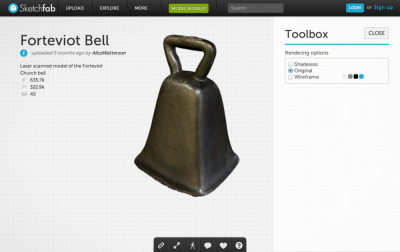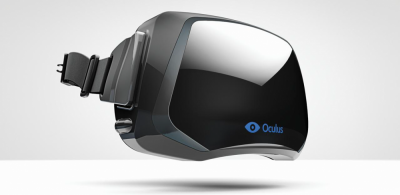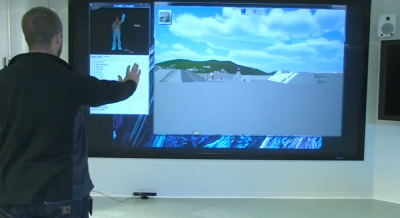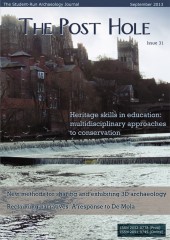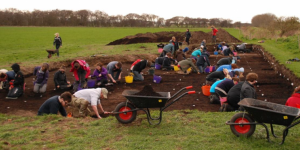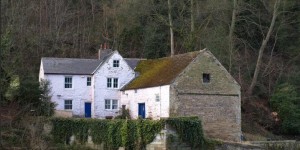In Issue 6 of this publication, my dissertation supervisor, Dr Anthony Masinton, contributed an article detailing some of the latest and most exciting intersections between archaeology and 3D graphics (Masinton 2009). In my experience, articles of this type do not appear as often as they ought to in archaeological publications. The digital humanities have a tendency to ‘re-invent’ themselves on a regular basis to keep up with continuing advances in computer hardware and software, and it seems as though this deters some potential writers. After all, it is difficult to make definitive statements about a discipline which remains in a state of flux.
Be that as it may, this article presents some new developments in computer software in hardware which may be of use to digital archaeology, both now and in the near future. I feel it is important for archaeologists to follow emerging technologies, and begin the critical process of asking “how can this be used for archaeology?” as they appear. I have also been dwelling recently on an article by Llobera (2011, 217), who states that, “there has been limited effort to inform archaeologists on how IT [Information Technology] may be integrated within current archaeological discussions ... [and] foster a deeper conceptual understanding of how ... IT may precipitate new ways of doing archaeology beyond what is readily available”. The purpose of this article is, in part, to help combat this perceived lack of effort, whilst bringing to the attention of the reader some of the latest happenings in the computer graphics subset of IT, and exploring their applications within the discipline of archaeology.
My current research surrounds 3D archaeological visualisation – its application in the archaeological process, data transparency, best practices, and so forth. This is sometimes referred to as archaeological VR (virtual reality), VRM (virtual reality modeling), or, within the umbrella term, ‘digital heritage’. The subject matter presented below is comprised of new gadgets and applications which reflect this interest, and enable the creation, display, and distribution of archaeological 3D content. Some of the issues attached to what is presented will also be introduced. This is by no means a complete ‘taxonomy’ of potential visualisation technologies, but a rather heavily curated selection.
3D models on the web
A great deal of time and effort goes into the creation of complex 3D models, and that effort is poorly represented if the model ends up represented only be a mere handful of images in a journal article. Rather, it is more rewarding to have a platform with which models themselves may be shared, and experienced fully by their intended audience.
In the information age, the most efficient way to deliver content to a wide audience is to make it available on the internet. The methods for hosting 3D content online may be divided roughly into two categories: making files available for download, which must be viewed on the user’s machine; and giving users the ability to view content directly within a web browser. The former option allows the highest degree of control over how the model is viewed and manipulated, but can also be problematic as downloaded models often require some kind of specialty software to view. On the other hand, the latter makes content much easier to access, but allows less freedom of interaction with the subject.
In recent years, a number of platforms for sharing models directly within internet browsers have been developed and refined. One of these is the Unity Web Player, which allows interactive 3D content to be displayed in an internet browser with the installation of a special plug-in. The player was used recently to present a visualisation of the Guild Chapel in Stratford-upon-Avon in Issue 32 of Internet Archaeology (Giles et al. 2012). Another is the integration of 3D content directly into web pages through the use of WebGL and HTML5, which has the significant advantage of running in any modern browser (such as Google Chrome or Mozilla Firefox) without the need to install any plug-ins. This platform is utilised by CyArk’s online archive of 3D content (http://archive.cyark.org). However, in my opinion, the most exciting new platform for sharing models online is Sketchfab, which builds upon the ‘out-of-the-box’ HTML5 solution used by CyArk.
Sketchfab is a complete service aimed at facilitating the quick and easy sharing of models on the web. It is free for non-commercial use, but an upgrade to its ‘Pro’ version with a monthly subscription fee is required for those hoping to publish larger, more complicated content. The Sketchfab website also features a wealth of documentation to help users optimise their content for use with the service, which includes instructions for importing models created using free software like Blender or SketchUp.
(Reproduced with kind permission of Alice Watterson, Glasgow School of Art, Digital Design Studio)
This powerful sharing platform has not escaped the notice of digital heritage professionals, a point which may easily be proven by visiting the Sketchfab model portal, and searching for content with the term, ‘archaeology’. The results include a number of models of small artefacts, and even buildings created by both professionals and hobbyists. One example is a model of the Forteviot church bell created by Watterson (2013) for the University of Glasgow’s Department of Archaeology (Figure 1).
While the solutions outlined above offer exciting ways to distribute content to a wide audience, the issue of sustainability should be considered when discussing any online sharing method. One of the goals outlined by the London Charter – a set of best practices for computer-based visualisations – is the sustainability of digital heritage content. The charter states that “strategies should be ... implemented to ensure the long-term sustainability of ... visualisation outcomes and documentation, in order to avoid loss of this growing part of human intellectual, social, economic and cultural heritage” (Denard 2009, Section 5.0). While the degree to which the London Charter is accepted and utilised by heritage professionals is subject for debate (and has been considered elsewhere, such as in Hermon et al. 2007), it often serves as a useful starting point for discussion, as I believe it does here. Thus, it is possible to derive a question from the London Charter in this context: Is making visualisations available on the internet a sustainable practice? Content will only be available to users so long as it is hosted, which requires financial backing – albeit not a considerable amount.
A consideration of the article by Masinton (2009) mentioned in my introduction provides a miniature case study for the sustainability of content on the web. Of the several projects mentioned in his discussion of 3D archaeology, two (the Venus Project, and IBM’s Forbidden City Online) no longer appear to have any active online presence. While only four years have passed since their mention in publication, it would seem that shifting priorities in either research interests or funding have no longer made them viable.
However, in contrast to these are projects which have stood the test of time, and continue to remain online. For instance, the Rome Reborn project (romereborn.frischerconsulting.com) has remained online, and has since been updated with an abundance of new content. It would seem that, like the results of any academic endeavour, the continued availability of project outputs is dependent upon maintaining outside interest, and capitalising upon opportunities to update content.
Upcoming gadgets
The recent announcement that gaming aficionado John Carmack has assumed the role of Chief Technology Officer for tech startup, Oculus VR, caused quite a stir within the gadget and gaming communities. For the uninitiated, Carmack is one of the founding members of id Software, which pioneered 3D gaming in the early 1990s with the release of Doom and Wolfenstein 3D. As for Oculus VR, the company is currently working to revolutionise the world of gaming with its creation of the Oculus Rift (Figure 2), a wearable VR headset. This happening may seem unconnected to the world of archaeology, but I believe the long preoccupation of digital heritage professionals with creating virtual realities grants it some significance.
Wearable VR technologies tend to surface now and again, only to fade quickly into obsolescence or disinterest. This tends to be because the output is bulky or otherwise uncomfortable, and in many cases it is difficult to create content for them to display. However, the Oculus Rift has thus far managed to avoid the fate of its predecessors, and has exhibited an inordinate influence over the market. The Kickstarter crowd-funding campaign that the company opened to fund the project received over ten times its initial funding goal of $250,000 USD, and a number of big names in the gaming industry (including Valve, Epic Games, and Unity) have expressed an interest in adopting the technology (anon. nd).
Should the Rift continue to enjoy this level of success, it has the potential to become an ideal solution for enabling more accessible archaeological virtual realities. The cooperation with ‘out-of-the-box’ development kits facilitated by its industry partners should allow archaeologists to spend less time cobbling together do-it-yourself hardware setups, and more time creating and enriching the content that they want to display.
Keeping within the realm of gaming technologies, the forthcoming Xbox One console from Microsoft is due to be released some time in the final quarter of this year, and with it will ship an updated version of its ‘hands-free’ controller, Kinect. Although originally marketed purely as a gaming experience, a bit of creative ‘hacking’ has allowed the Kinect to evolve into an inexpensive 3D scanner, and has been put to use as such by archaeologists.
One solution, created by researchers at the University of California, San Diego, is called ArKinect, and was developed in order to create quick scans of excavation sites in the field (Boyle 2011). Another, associated with the MayaArch3D project (mayaarch3d.unm.edu), explored the possibility of using Kinect to navigate a 3D Mayan cityscape (Richards-Rissetto et al. 2012) (Figure 3). As the new Kinect will feature significantly higher degrees of accuracy and fidelity, it, too, has the potential to become an effective, low-cost archaeological recording tool.
Conclusion
For some, looking at emerging technologies and asking what they might have to offer to the discipline of archaeology has a somewhat paradoxical undertone. It can be argued that in doing so, one runs the risk of carrying out work which is more a valorisation of new and exciting technological approaches than an attempt to choose technology that will best suit pre-existing research aims (Earl and Wheatley 2002, 5; as cited in Watterson 2012, 21).
It is my opinion that an up-to-date awareness of which technological solutions are available to undertake a given task is essential, and that so long as new methods are engaged with in a critical fashion, there is no reason to assume that technological approaches will be chosen in an arbitrary fashion. Archaeology is very much a multidisciplinary practice, and as such it would not do to avoid the latest offerings of a discipline with the potential to provide a fresh new outlook on traditional archaeological subject matter.
Bibliography
- anon. nd. ‘About Oculus VR’. Oculus VR. Available at: http://oculusvr.com/company [Accessed 15th August 2013]
- Boyle, R. (2011) ‘Archaeologists use a hacked Kinect to create 3-D scans of dig sites’. Popular Science Online. Available at: http://popsci.com/technology/article/2011-08/archaeologists-will-use-hac... [Accessed 15th August 2013]
- Denard, H. (2009) The London Charter for the Computer-Based Visualisation of Cultural Heritage (Draft version 2.1). Available at: http://londoncharter.org/downloads.html [Accessed 15th August 2013]
- Earl, G. and Wheatley, D. (2002) ‘Virtual reconstruction and the interpretative process: A case-study from Avebury’, in D. Wheatley, G. Earl and S. Poppy (eds.) Contemporary Themes in Archaeological Computing. Oxford: Oxbow Books. 5-15
- Giles, K., Masinton, A. and Arnott, G. (2012) ‘Visualising the Guild Chapel, Stratford-upon-Avon: digital models as research tools in buildings archaeology’. Internet Archaeology. 32. Available at: intarch.ac.uk/journal/issue32/1 [Accessed 15th August 2013]
- Hermon, S., Sugimoto, G. and Mara, H. (2007) ‘The London Charter and its Applicability’, in D. Arnold, F. Niccolucci and A. Chalmers (eds.) Future Technologies to Empower Heritage Professionals, VAST 2007. Geneva: Eurographics Association. 11-14
- Llobera, M. (2011) ‘Archaeological Visualization: Towards an Archaeological Information Science (AISc)’. Journal of Archaeological Method and Theory. 18 (2). 193-223
- Masinton, A. (2009) ‘Laser scanning to Assassin’s Creed: What’s cool in 3D archaeology’. The Post Hole. 6. 2-10
- Richards-Rissetto, H., Remondino, F., Agugiaro, G., Robertson, J., von Schwerin, J. and Girardi, G. (2012) ‘Kinect and 3D GIS in archaeology’, in F. Ferrise (ed.) 18th International Conference on Virtual Systems and Multimedia – Proceedings. 331-337
- Watterson, A.E. (2012) ‘The Value and Application of Creative Media to the Process of Archaeological Reconstruction and Interpretation’, in A. Chrysanthi, P.M. Flores and C. Papadopoulos (eds.) Thinking Beyond the Tool: Archaeological Computing and the Interpretive Process. British Archaeological Reports: International Series. 2344. Oxford: Archaeopress. 14-23
- Watterson, A.E. (2013) ‘Structured-Light Scanning of the Forteviot Bell’. Digital Dirt, Virtual Pasts. Available at: http://digitaldirtvirtualpasts.wordpress.com/2013/04/25/laser-scanning-t... [Accessed 15th August 2013]


